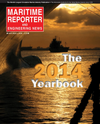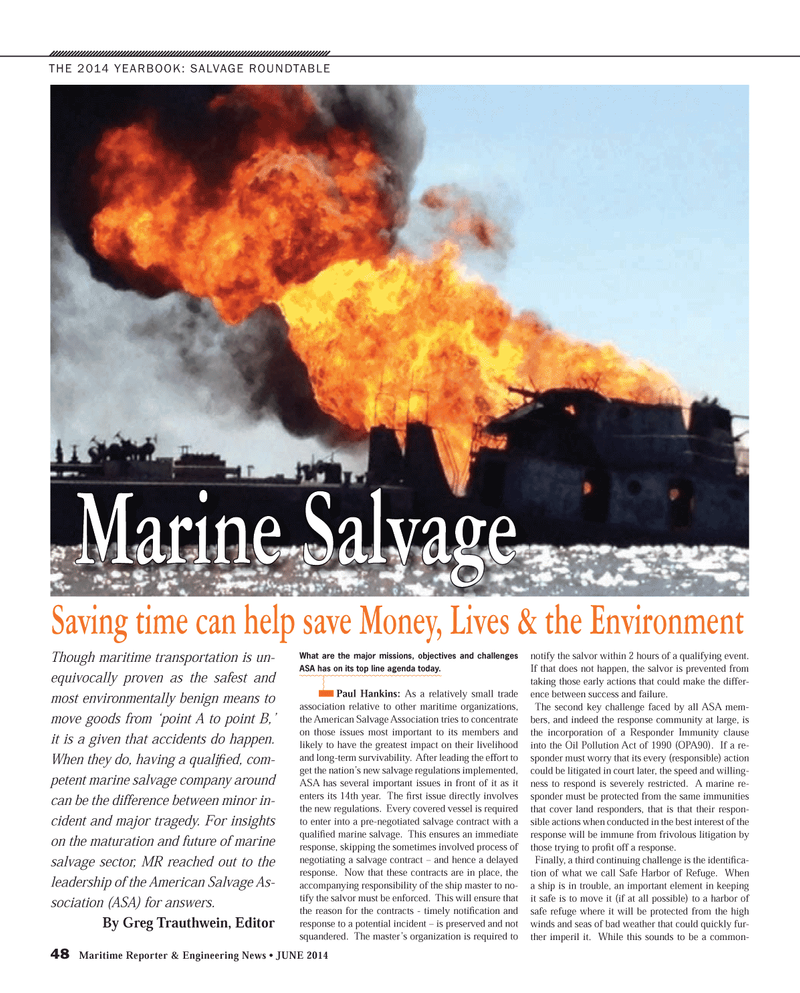
Page 48: of Maritime Reporter Magazine (June 2014)
Annual World Yearbook
Read this page in Pdf, Flash or Html5 edition of June 2014 Maritime Reporter Magazine
48 Maritime Reporter & Engineering News • JUNE 2014
THE 2014 YEARBOOK: SALVAGE ROUNDTABLE
What are the major missions, objectives and challenges
ASA has on its top line agenda today.
Paul Hankins: As a relatively small trade association relative to other maritime organizations, the American Salvage Association tries to concentrate on those issues most important to its members and likely to have the greatest impact on their livelihood and long-term survivability. After leading the effort to get the nation’s new salvage regulations implemented,
ASA has several important issues in front of it as it enters its 14th year. The ? rst issue directly involves the new regulations. Every covered vessel is required to enter into a pre-negotiated salvage contract with a quali? ed marine salvage. This ensures an immediate response, skipping the sometimes involved process of negotiating a salvage contract – and hence a delayed response. Now that these contracts are in place, the accompanying responsibility of the ship master to no- tify the salvor must be enforced. This will ensure that the reason for the contracts - timely noti? cation and response to a potential incident – is preserved and not squandered. The master’s organization is required to notify the salvor within 2 hours of a qualifying event.
If that does not happen, the salvor is prevented from taking those early actions that could make the differ- ence between success and failure.
The second key challenge faced by all ASA mem- bers, and indeed the response community at large, is the incorporation of a Responder Immunity clause into the Oil Pollution Act of 1990 (OPA90). If a re- sponder must worry that its every (responsible) action could be litigated in court later, the speed and willing- ness to respond is severely restricted. A marine re- sponder must be protected from the same immunities that cover land responders, that is that their respon- sible actions when conducted in the best interest of the response will be immune from frivolous litigation by those trying to pro? t off a response.
Finally, a third continuing challenge is the identi? ca- tion of what we call Safe Harbor of Refuge. When a ship is in trouble, an important element in keeping it safe is to move it (if at all possible) to a harbor of safe refuge where it will be protected from the high winds and seas of bad weather that could quickly fur- ther imperil it. While this sounds to be a common-
Marine Salvage
Though maritime transportation is un- equivocally proven as the safest and most environmentally benign means to move goods from ‘point A to point B,’ it is a given that accidents do happen.
When they do, having a quali? ed, com- petent marine salvage company around can be the difference between minor in- cident and major tragedy. For insights on the maturation and future of marine salvage sector, MR reached out to the leadership of the American Salvage As- sociation (ASA) for answers.
By Greg Trauthwein, Editor
Saving time can help save Money, Lives & the Environment
MR #6 (40-49).indd 48 6/9/2014 11:15:57 AM

 47
47

 49
49
